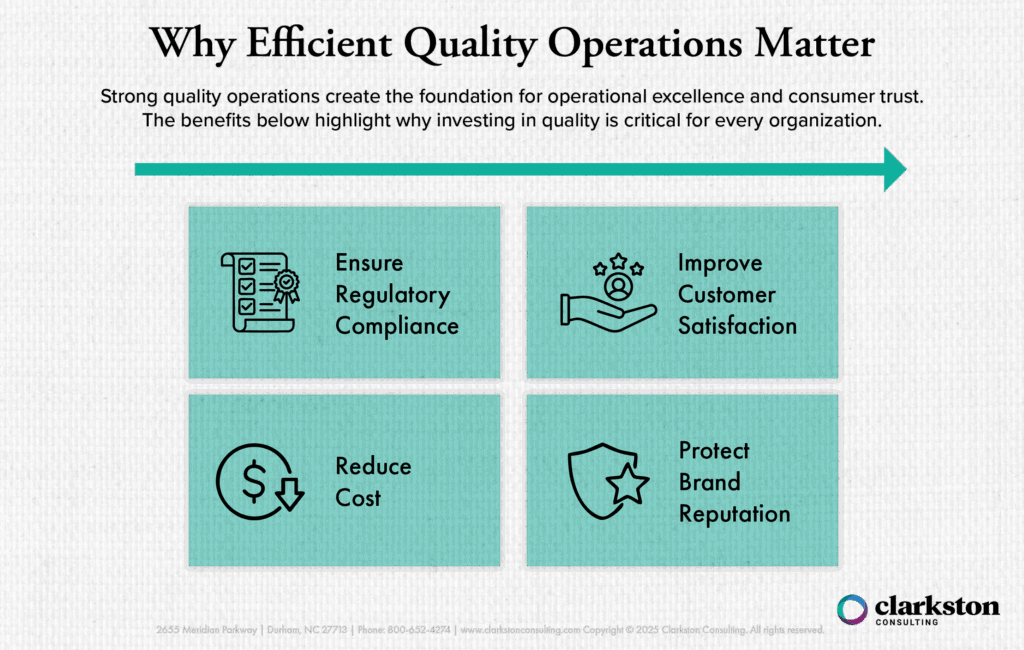Enhancing Quality Operations in Consumer Products: A Strategic Imperative
Amid today’s supply chain uncertainty and volatile geopolitical landscape, companies are having to be increasingly selective about where they focus their investments. Particularly within a competitive consumer products industry – spanning sectors like health, beauty, food, and beverage – maintaining high-quality standards while optimizing operational efficiency is turning into a business necessity rather than a “nice to have.” Rapid changes within the quality space will likely be increasingly necessary as businesses deal with changing tariff strategies, food safety initiatives, and other dynamics arising from Executive branch actions. Enhancing quality operations in consumer products is a strategic imperative.
Embedding quality within operational business processes plays a critical role in supporting a resilient, responsive supply chain and ensuring that products consistently meet both regulatory requirements and customer expectations. Below, we explore how consumer products companies can enhance their quality operations by aligning their investments across supply chain and quality systems, and why doing so is essential to protect and elevate the entire value chain.
Why Efficient Quality Operations Matter
Efficient quality operations are foundational to both short-term performance and long-term success. Here’s why:
1. Regulatory Compliance: Meeting quality standards ensures compliance with evolving regulations and avoids costly recalls, legal risks, and reputational damage. Regulatory requirements vary within different consumer product sectors, but one thing is consistent – established product specifications need to be met. This means business processes need to be designed to establish the controls necessary to directly or indirectly support this mandate.
2. Customer Satisfaction: Delivering consistent, high-quality products that meet customer expectations builds customer trust and loyalty. A satisfied customer is not only more likely to return, but they’re also more likely to advocate for your brand. The key is understanding your customer’s needs and then consistently meeting or exceeding those expectations.
3. Cost Reduction: Streamlined operations can help minimize waste, lower production costs, and reduce the frequency and severity of product defects. The best approach is to design quality into your key operational processes and products and then use a continuous improvement program to address non-conformances, customer feedback, and improvements.
4. Brand Reputation: Companies that are known for quality earn a premium in the market and enjoy long-term brand equity. Brand reputation shapes how consumers perceive the quality of a product before they even use it. Over time, repeated positive experiences with a product can reinforce its reputation for quality. Poor product performance can tarnish a reputation quickly, and it can be hard to recover from significant quality issues.

Embedding quality into operational business processes is essential for sustained customer satisfaction and long-term brand reputation – plus, it can help ensure regulatory compliance and cost reduction priorities are consistently met. This is critical to have a resilient, responsive supply chain while ensuring your products consistently meet both regulatory requirements and customer expectations.
Key Quality Processes in Consumer Product Companies
To ensure consistent quality, CP companies can implement a range of core quality operations, including:
- In-process Testing: Continuous monitoring of quality during production to catch and correct issues in real time.
This will allow for small issues to be addressed before they become significant issues impacting product quality. With robust in-process testing, defects can be prevented and product release times can be reduced, thereby getting the product to market faster. The further upstream you can integrate quality control, such as raw materials being tested before being used, the better your results.
- Release Testing: Verifying final product quality before market release to ensure they meet all quality criteria.
Release testing can be streamlined in some cases with robust online testing during the production run. In other cases, parametric release may be feasible without further finished goods testing. This is your last chance to ensure the products will meet the product specifications and customers’ expectations.
- Customer Complaints: Gathering, analyzing, and acting on customer feedback to identify and resolve issues and drive improvement.
It’s imperative that a product meets customer expectations, so what better input do we have than direct feedback from the customers. In some cases, this voice of customer can be gathered systematically and integrated into the feedback process; other times it may involve an escalation process that results in market action, such as a product recall.
- Audit/Inspection Management: Conducting regular internal and external reviews to ensure compliance with standards.
Internal audits are your chance to discover where improvements are needed and where excellent practices exist that should be shared with others. External audits give you a chance to partner with your suppliers to ensure quality at the source. Many consumer goods are subject to regulatory body inspections or customer audits. A Quality Management System (QMS) can offer improved audit preparation and transparent tracking of supplier status, helping reduce risk of non-compliance and better communicate with your suppliers.
- Learning and Training Management: Equipping teams with up-to-date knowledge of quality standards and procedures.
Every employee should understand how to perform their work efficiently and safely to obtain “right first time” results. Certification programs utilizing training management systems are popular to ensure initial and refresher training are successfully accomplished.
- Document Management: Ensuring all quality protocols, test results, and compliance documents are properly maintained.
Accessibility, traceability, and data security require efficient and trustworthy document management systems (DMS). Organizational change management is also supported by life-cycle documentation. While it is possible to do this manually, most firms employ quality management systems (QMS) and/or DMS as document repositories to handle and centralize document life-cycle reviews and approvals.
- Supplier Management: Collaborating with suppliers to enforce quality standards throughout the supply chain.
Ensure you have a robust third-party risk management process for identifying, assessing, mitigating, and monitoring risks posed by suppliers and vendors. This is critical to minimize exposure to financial losses, reputational damage, and legal liabilities associated with your supplier and vendor relationships.
Having these seven quality processes firmly in place as part of your operation provides the environment needed to ensure that products consistently meet both regulatory requirements and customer expectations while also enabling a resilient, responsive supply chain.
Strategies to Improve Quality Operations Efficiency
To keep pace with market demands while maintaining quality, companies must also continuously refine their operations or risk losing their customers to their more agile competitors. Here are some proven strategies:
1. Process Documentation Using SIPOC: Mapping processes using the SIPOC (Suppliers, Inputs, Process, Outputs, Customers) model helps visualize the value chain, note areas of rework, analyze workflows, pinpoint inefficiencies for improvement, and ensure all stakeholders are aligned.
2. Cross-Functional Collaboration: Breaking down silos between departments, like manufacturing, quality assurance, and supply chain, fosters a unified approach to quality and enables faster problem-solving. This holistic approach ensures that quality is integrated into every aspect of the operation.
3. Leveraging Technology: Advanced tools such as artificial intelligence (AI), machine learning (ML), data analytics, and automated quality control systems can detect anomalies, track trends, provide real-time insights, and optimize decision-making.
4. Continuous Improvement Culture: Adopting methodologies like Lean, Total Quality Management (TQM), and Six Sigma encourages ongoing innovation, defect reduction, and process optimization. The Deming Plan-Do-Check-Act (PDCA) cycle is a very popular approach. The resulting culture of continuous improvement encourages employees to identify inefficiencies and suggest improvements.
5. Agile Response to Change: Creating agile systems and processes enables quick pivots in response to non-standard inputs, like new raw materials, supplier changes, or modified production methods, without compromising quality. This flexibility ensures that quality is maintained even in dynamic situations.
These five strategies enable agility to become a strategic advantage in keeping pace with market demands while maintaining quality within a resilient, responsive supply chain.
Final Thoughts
In an industry where trust and performance drive customer loyalty, efficient quality operations are key. Particularly during times of uncertainty, CP organizations must double-down on what they can control. From documentation and technology adoption to cross-functional integration and agility, improving quality efficiency can yield measurable benefits across the entire supply chain.
By prioritizing quality today, consumer products companies position themselves for sustained growth, stronger customer relationships, noteworthy brand reputation, and a lasting competitive edge. Further, aligning quality and supply chain investments can provide the reliable and resiliency needed to stay competitive.
Clarkston’s team of Quality & Compliance experts has the experience needed to strategize with you to design and implement solutions associated with the topics raised here. Reach out to us if you have questions or need further information.




